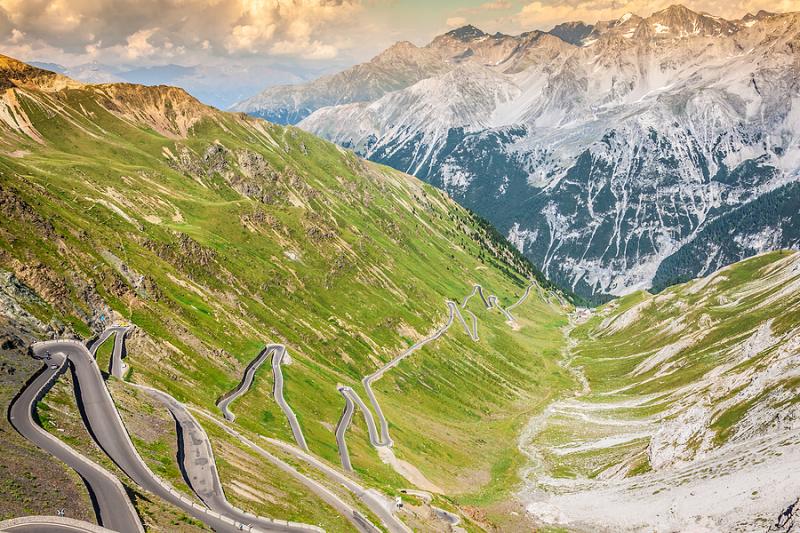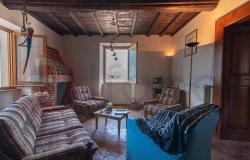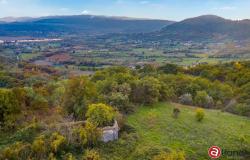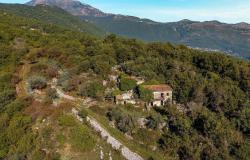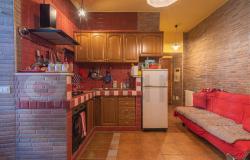We continue our series about road trip ideas in Italy with three exciting, very different itineraries, from thrilling mountain roads to gentle hilly landscapes to coastal panoramas with Middle-European flavors.
Strada dello Stelvio - The Stelvio Road
If you love driving mountain roads, this is the itinerary for you: the Stelvio Pass, the highest car pass in Italy, located at an altitude of 2,758 meters (9,050 feet) is a thrilling drive that includes 48 hairpin bends!
This road trip takes place along the State Road SS 38, the state road that connects Valtellina in Lombardy with the Val Venosta valley in Alto Adige (South Tyrol). It is 224 kilometers in total (140 miles), to be covered in at least three days, to take the time to enjoy some of the sights and towns along the way.
Starting in Piantedo, province of Sondrio, we recommend you first stop in Tirano, known for being the Italian terminus of the famous Bernina red train, the highest mountain railway line in Europe, connecting Tirano with the Swiss town of St. Moritz, crossing the Alps.
Second stop is Bormio, a popular winter sports resort, also famous for its numerous hot springs that provide water to three thermal baths, including the Bagni Vecchi, which boast an amazing view over Valtellina and the Stelvio National Park, a protected area that houses dozens of glaciers, including the Forni Glacier, one of the largest in Europe.
Then comes the most thrilling part as you prepare to face the 48 (!) hairpin bends that lead to the Stelvio Pass, which will likely be enveloped in clouds, as you are almost 3,000 meters high. The pass is only open June to September, so this is a summer itinerary.
Once you reach the other side of the pass, you’ll be entering Trentino-Alto Adige and begin the descent along the beautiful Val Venosta of South Tyrol. You should stop in Merano, an elegant spa town with a decidedly Austrian atmosphere. Take a walk in the famous gardens of Trauttmansdorff Castle, the most famous in South Tyrol, covering 12 hectares, with 80 dedicated displays of local, Mediterranean and exotic plants from around the world.

This road trip ends in Bolzano, the regional capital of South Tyrol. Spend at least half a day exploring its historic center and shopping under the arcaded streets. Try the local cuisine, a wonderful mix of Mediterranean and Austrian influences, and explore some of its castles: Castel Mareccio, Castel Roncolo, home to temporary exhibitions, and Castel San Firmiano, which houses the Messner Mountain Museum.
On the road from Trieste to Collio along the Italian-Slovenian border
For lovers of Central European atmospheres, this 90-kilometer (56 miles) itinerary is ideal. From Trieste to the Gorizia hills, an area known as Collio, you’ll spend three or four days near the border between Italy and Slovenia, an area that shares lovely views, vineyards and flavors.
This road trip begins in Trieste, where you should spend at least a day exploring the historic cafes on Piazza dell’Unità d’Italia, strolling along the Grand Canal, going up to the Castle, and visiting Orthodox churches and synagogues. Once the premier port of the great Hapsburg Empire, Trieste “has a unique atmosphere and is so different from other Italian cities. It oozes the atmosphere of Mittle-Europa and is greatly influenced by its location at the crossroads of Latin, Austro-Hungarian and Slavic cultures.”

Just seven kilometers outside Trieste is the Miramare Castle, built by Archduke Ferdinand Maximillian Joseph in 1855; on a rocky outcrop, it juts out over the sea; it is sumptuously furnished and surrounded by 54 acres of rare and exotic flora imported from around the world.
Less grand and not as well-known, but still worth a stop, is the Duino castle, to be visited together with the nearby town of Sistiana.
Continue to Aquileia, one of the main archeological sites of northern Italy and a Unesco World Heritage site. Visit the Basilica with its splendid floor mosaic, the remains of the Roman city, and the National Archaeological Museum, one of the most important in Italy for Roman antiquities.
This itinerary will also delight foodies. Head inland to explore the Collio, an expanse of vineyards where excellent white wines are made; these go alongside a strong-flavored cuisine with Austrian and Slovenian influences.

The foodie capital in the area is Cormons, where this itinerary ends: visit the lovely historic center, dine at one of the excellent restaurants and go wine tasting. About ten kilometers further on, conclude with a panoramic photo on top of the hill of the Rosazzo Abbey.
The Castelli Romani Road Trip
We decidedly change landscapes and atmosphere with this road trip up and down the Alban Hills, a tour through history, nature and gastronomy, on the road of the Castelli Romani, outside Rome.
The itinerary is around 100 kilometers (62 miles), to be covered in two or three days. On these hills not far from the Italian capital, the citizens of Rome found refuge when fleeing the crisis that enveloped the Papacy during the period of the Avignon captivity. Thus villages started to form around the castles of the powerful Roman feudal families of the Savelli, Annibaldi, Orsini and Colonna.
The Castelli Romani road trip is a tour to be savored slowly, because, besides stopping to savor the panoramas, such as those on Lake Albano and Lake Nemi, you will stop to savor the cuisine at the typical fraschette, sort of osterie, where you can try the famous local porchetta and other cured meats, accompanied by a glass of the local wines, such as the Castelli Romani, Frascati and Colli Albani.

Among the villages not to miss is Castel Gandolfo, where the pope keeps his summer residence in the 17th-century Palazzo Pontificio.
Also worth a visit are Villa Barberini, with its splendid gardens, and Villa Torlonia, which boasts an incomparable view of the Agro Romano, the rural area that surrounds Rome.
About ten kilometers from Castel Gandolfo is Frascati, famous for Villa Aldobrandini and for its historic center, where, among narrow alleys, the historic cellars have been turned into restaurants.
